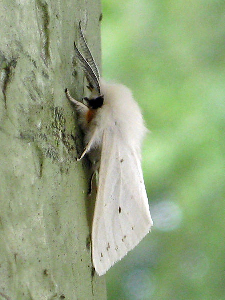In the spring we saw tents in the trees. Now we see webs. Though similar in concept, the structures aren’t made by the same species.
The springtime tent, located in the crotch of a tree, is made by eastern tent caterpillars (Malacosoma americanum) who emerge from their tent to eat young leaves as they unfurl. The webs, located on the branches, are made by fall webworms (Hyphantria cunea) who hide in the web and eat leaves that will fall off in a month or two.
Since late summer female moths have been laying egg masses on deciduous trees.

After a week the eggs hatch into tiny caterpillars who build a web to completely enclose themselves and their food. As they eat, they build the web larger to enclose more leaves.
Fall webworms avoid coming out of the web until they’re ready to pupate. Then they hide their cocoons under flaps of bark to overwinter and emerge next year.
Though the webs look ugly they don’t harm the trees because the leaves will drop soon anyway.
See webworms in action in the video above from The Capitol Naturalist in D.C. Read more in this vintage article from 2011: Coming Soon To A Tree Near You
(photo of fall webworm moth from Wikimedia Commons; click on the image to see the original)